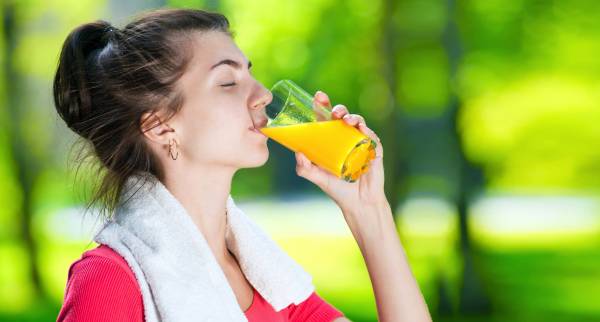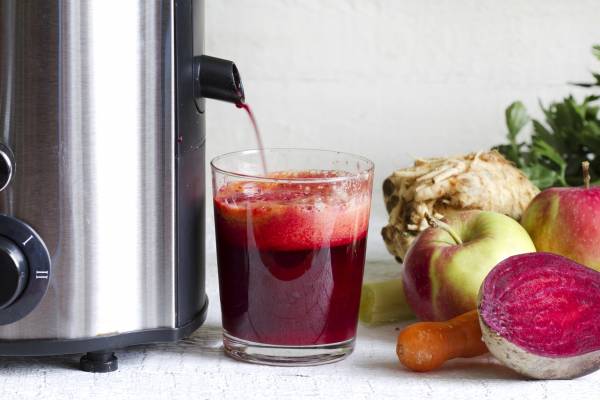Many studies show that a high soft drink intake is associated with an increased energy intake and an increase in body weight. Soft drinks consumption is also correlated to a decreased intake in calcium and other nutrients, as well as an increased risk of many diseases such as diabetes. This is due to the high amount of sugar in a can of soft drink.
When it comes to sugar content, soft drinks and juice really aren’t that different.
Indeed, daily soft drink consumers (people who consume one or two cans per day or more) have a 26 % greater risk of developing type 2 diabetes when compared to people who rarely consume soft drinks.1 It has also been shown that consuming on average one can of a sugary beverage per day increases the risk of having a heart attack by 20%.2
However, fruit juices also contain high amounts of sugar. A twelve-ounce (350 mL) Coca Cola contains 140 calories and 40 grams of sugar while the same amount of apple juice contains 165 calories and 39 grams of sugar.
One may argue that fruit juices contain vitamins and antioxidants, which is true – but they contain much less than un-juiced fruit. During processing fruit juices lose some of their nutritional value. Furthermore, because fruit juices contain no fiber, they do not provide a sensation of satiety compared to whole fruits.
What About Athletes?
Because athletes consume a lot of calories and need a quick and easy-to-digest source of carbohydrates when they workout, it is okay for them to consume fruit juices occasionally. But the timing of when you consume that glass of fruit juice is important.
“Make sure to dilute the dilute the juice with water and add a pinch of salt to replace the electrolytes lost during your training.”
If you are working out in the morning and want a quick source of energy, you could drink a glass of juice. But if you are training a few hours or more after breakfast, then you should instead consume whole fruits, such as a banana, an apple, or grapes. The fiber content of whole fruit will help regulate your blood sugar level so you will have energy for a longer period of time and won’t experience a sudden drop.

Timing is important if you’re going to drink juice to support your workouts.
Also, instead of drinking a sports or soft drink during a long bike ride or run, you could drink a little bit of fruit juice. A good drink for during exercise should contain between six to eight percent of carbohydrates.3
Make sure to dilute the juice with water and add a pinch of salt to replace the electrolytes lost during your training. If you drink a non-diluted fruit juice while working out, it won’t be digested properly and you may experience gastrointestinal issues.
The Good Stuff
Even though fruit juices contain as much sugar and calories as soft drinks and they are not really much more nutritious, fruit juices don’t contain the many unhealthy ingredients that soft drinks can:
- Soft drinks contain high levels of phosphate and consuming more phosphate than calcium may negatively impact the health of your bones.4
- Also, phosphoric acid is detrimental for the health of the teeth.
- Most soft drinks contain artificial flavors and color as well as preservatives.
Furthermore, the amount of soft drinks consumed is typically inversely related to the amount of milk a person consumes. Therefore, a person who drinks soft drinks regularly may be calcium deficient. This point is crucial for children and adolescents because their bones are still being built.
Is Juicing Okay?
Depending on what you are juicing and how you are doing it, juicing at home can be healthy. For instance, freshly squeezed orange juice contains more vitamins and antioxidants than the typical orange juice bought at the supermarket – and it tastes a lot better. But it still doesn’t contain the fiber of whole fruit and does contain as much sugar and calories.
“Juicing at home is a great way to save money because beet juices, as well as carrots juices, are really expensive at the supermarket.”
On the other hand, if you blend fruits along with leafy greens like kale or spinach and vegetables such as carrots, you obtain a nutrient-dense juice that also contains fiber. Juicing kale, carrots, and beets is a great way to easily consume more vegetables. And beets are also known to improve performance due to the presence of nitrates. Juicing at home is a great way to save money because beet juices, as well as carrots juices, are really expensive at the supermarket.

Juicing makes it easy to consume more vegetables.
If you want to buy a juicer you can choose between a centrifugal juice extractor and cold press juicer, also known as a masticating juicer. A cold press juicer produces less heat and therefore the nutrients in the fruits and vegetables stay more intact. However, it is more expensive.
If you want to blend (as opposed to juice) your fruits and vegetables and keep all the fiber, then just buy a really good blender, such as a Vitamix. You will obtain a denser texture and it is much more satiating.
Do you have any favorite vegetable and juice combos that you use? If so, please post them to the comments below.
More Like This:
- 10 Day Juice Fast: Is Juicing Good for You?
- Getting Started With Juicing: What You Need to Know
- Cleanses, Detoxes, and Juice Fasts: Do They Work?
- New on Breaking Muscle Today
References:
1. Malik VS, Popkin BM, Bray GA, Despres JP, Willett WC, Hu FB. Sugar-sweetened beverages and risk of metabolic syndrome and type 2 diabetes: a meta-analysis, Diabetes Care. 33:2477-83, 2013.
2. de Koning L, Malik VS, Kellogg MD, Rimm EB, Willett WC, Hu FB. Sweetened beverage consumption, incident coronary heart disease, and biomarkers of risk in men. Circulation. 125:1735-41, S1, 2012.
3. Eberle, Suzanne. Endurance Sports Nutrition. Human Kinetics. 2007
4. Harvard School of Public Health. “Soft drinks and disease.” Accessed August 9th, 2015.
Photos courtesy of Shutterstock.






